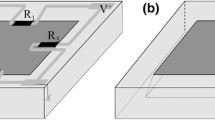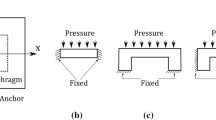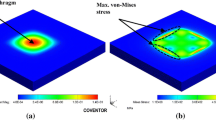Abstract
This work focuses on enhancing the sensitivity and reducing the wheatstone bridge non-linearity of the current designs of Micro-Electro-Mechanical systems pressure sensor. Conventionally there are four piezoresistors on the four edges of a square diaphragm. These four peizoreistors give rise to a change in resistance with input stress which is converted to voltage using a wheatstone bridge so that it can be measured. In this renewed proposed design, there are a total of eight sensors on the diaphragm; four dedicated to the compressive and tensile stress on the XX – plane and the other four for the YY – plane. Compressive and tensile forces have similar magnitude but act in opposite directions which isn’t considered in the conventional designs, leading to non-linearity. Thus the non-linearity due to the sign difference in compressive and tensile forces is accounted for by calculating them separately and doubling the sensitivity. Each of these eight sensors include two piezoresistors; one attached to the diaphragm and the other outside forming a hairpin structure. Instead of using the wheatstone bridge for measuring the voltage, we make use of operational amplifiers. Thus removing the wheatstone bridge non–linearity.












Similar content being viewed by others
References
Bakhoum EG, Cheng MHM (2010) Capacitive pressure sensor with very large dynamic range. IEEE Trans Compon Packag Technol 33(1):79–83
Bao M (2005) Analysis and design principles of MEMS devices. Elsevier, Amsterdam
Bao M Analysis and design principles of MEMS devices
Bao M, Yu L, Wang Y (1991) Stress concentration structure with front beam for pressure sensor. Sensors Actuators A Phys 28(2):105–112
Beeby SP, Stuttle M, White NM (2000) Design and fabrication of low cost microengineered silicon pressure sensor with linearized output. Proc IEEE Sci Meas Technol 147(3):127–130
Bustillo JM, Howe RT, Muller RS (1998) Surface micromachining for microelectro mechanical systems. Proc IEEE 86(8)
Daigle M, Corcus J, We K (2007) An analytical solution to circular touch mode capacitor. IEEE Sensors J 7(4):502–505
Han J, Shannon MA (2009) Smooth contact capacitive pressures sensors in touch and peeling mode operation. IEEE Sensors J 9(3):199–206
Hayati M, Fathipour M, Vaziri HM (2018) Design and analysis of hairpin piezoresistive pressure sensor with improved linearity using square and circular diaphragms. Micro & Nano Letters 13(7):1046–1051
Kumar SS, Pant BD (2014) Polysilicon thin film piezoresistive pressure microsensor: design, fabrication and characterization, vol 21. Springer-Verlag, Berlin Heidelberg, pp 1949–1958
Kumar SS, Pant BD (2014) Design principles and considerations for the ‘ideal’ silicon piezoresistive pressure sensor: a focused review, vol 20. Springer-Verlag, Berlin Heidelberg, pp 1213–1247
Kumar SS, Pant BD (2015) Effect of piezoresistor configuration on output characteristics of piezoresistive pressure sensor: an experimental study. Springer-Verlag, Berlin Heidelberg
Nallathambi A, Shanmuganantham T (2015) Performance analysis of slotted square diaphragm for mems pressure sensor. Journal on Microelectronics 1(2):62–67
Nguyen D, Pillatsch P, Zhu Y, Paprotny I, Wright PK, White RD (2015) MEMS-based capacitive pressure sensors with pre-stressed sensing diaphragms. IEEE
Rajavelu M, Sivakumar D, Rathnam JD, Sumangala K (2013) Enhanced sensitivity with extended linearity in MEMS piezoresistive pressure sensor. Micro & Nano Letters 8(10):753–756
Ripka P, Tipek A (eds) (2013) Modern sensors handbook. Wiley, New York
Suja KJ, Kumar GS, Nisanth A, Komaragiri R (2014) Dimension and doping concentration based noise and performance optimization of a piezoresistive MEMS pressure sensor. Springer-Verlag, Berlin Heidelberg
Tufte ON, Chapman PW, Long D (1962) Silicon diffused-element piezoresistive diaphragms. J Appl Phys 33(11):3322–3327
Xu G, Guangwen C, Guoquing H (2001) A surface micro machined double sided touch mode capacitive pressure sensor. Society of Photographic Instrumentation Engineers 4601:25–30
Author information
Authors and Affiliations
Corresponding author
Additional information
Responsible Editor: B. C. Kim
Publisher’s Note
Springer Nature remains neutral with regard to jurisdictional claims in published maps and institutional affiliations.
Rights and permissions
About this article
Cite this article
Jindal, S.K., De, R., Kumar, A. et al. Novel MEMS Piezoresistive Sensor with Hair-Pin Structure to Enhance Tensile and Compressive Sensitivity and Correct Non-Linearity. J Electron Test 36, 509–517 (2020). https://doi.org/10.1007/s10836-020-05895-0
Received:
Accepted:
Published:
Issue Date:
DOI: https://doi.org/10.1007/s10836-020-05895-0




